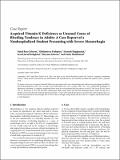| dc.contributor.author | Zekavat, Omid Reza | |
| dc.contributor.author | Fathpour, Gholamreza | |
| dc.contributor.author | Haghpanah, Sezaneh | |
| dc.contributor.author | Dehghani, Seyed Javad | |
| dc.contributor.author | Shakibazad, Nader | |
| dc.contributor.author | Zekavat, Seyedeh M. | |
| dc.date.accessioned | 2017-09-05T15:44:40Z | |
| dc.date.available | 2017-09-05T15:44:40Z | |
| dc.date.issued | 2017-08 | |
| dc.date.submitted | 2017-06 | |
| dc.identifier.issn | 2090-6684 | |
| dc.identifier.issn | 2090-6692 | |
| dc.identifier.uri | http://hdl.handle.net/1721.1/111121 | |
| dc.description.abstract | We report a rare case of acquired vitamin K deficiency presenting with severe menorrhagia and without any gynecological problem. Partial thromboplastin time (59.2 seconds) and prothrombin time (33.1 seconds, INR: 5.97) were considerably prolonged in laboratory evaluations. A complete coagulation factor assay test was performed for the patient: factor IX, 24%; factor II, 41%; factor VII, 3%; and factor X, 52%. She had been taking many high-energy drinks and she had inadequate dietary intake for the past 6 months. Given that she had vitamin K deficiency (VKD), a course of vitamin K therapy was started for her in the hospital. This case showed the potential for menorrhagia due to VKD with use of high-energy drinks and the value of a complete and detailed history in early diagnosis. | en_US |
| dc.publisher | Hindawi Publishing Corporation | en_US |
| dc.relation.isversionof | http://dx.doi.org/10.1155/2017/4239148 | en_US |
| dc.rights | Creative Commons Attribution | en_US |
| dc.rights.uri | http://creativecommons.org/licenses/by/4.0/ | en_US |
| dc.source | Hindawi Publishing Corporation | en_US |
| dc.title | Acquired Vitamin K Deficiency as Unusual Cause of Bleeding Tendency in Adults: A Case Report of a Nonhospitalized Student Presenting with Severe Menorrhagia | en_US |
| dc.type | Article | en_US |
| dc.identifier.citation | Zekavat, Omid Reza et al. "Acquired Vitamin K Deficiency as Unusual Cause of Bleeding Tendency in Adults: A Case Report of a Nonhospitalized Student Presenting with Severe Menorrhagia." Case Reports in Obstetrics and Gynecology 2017, 4239148 ( August 2017) © 2017 Omid Reza Zekavat et al | en_US |
| dc.contributor.department | Massachusetts Institute of Technology. Department of Biological Engineering | en_US |
| dc.contributor.mitauthor | Zekavat, Seyedeh M. | |
| dc.relation.journal | Case Reports in Obstetrics and Gynecology | en_US |
| dc.eprint.version | Final published version | en_US |
| dc.type.uri | http://purl.org/eprint/type/JournalArticle | en_US |
| eprint.status | http://purl.org/eprint/status/PeerReviewed | en_US |
| dc.date.updated | 2017-09-02T07:00:19Z | |
| dc.language.rfc3066 | en | |
| dc.rights.holder | Copyright © 2017 Omid Reza Zekavat et al. This is an open access article distributed under the Creative Commons Attribution License, which permits unrestricted use, distribution, and reproduction in any medium, provided the original work is properly cited. | |
| dspace.orderedauthors | Zekavat, Omid Reza; Fathpour, Gholamreza; Haghpanah, Sezaneh; Dehghani, Seyed Javad; Zekavat, Maryam; Shakibazad, Nader | en_US |
| dspace.embargo.terms | N | en_US |
| mit.license | PUBLISHER_CC | en_US |
